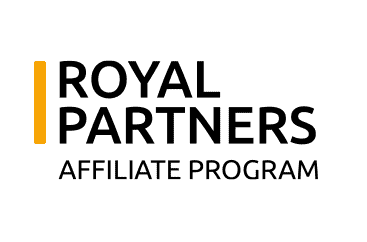Making an Affiliate Marketing Business Plan
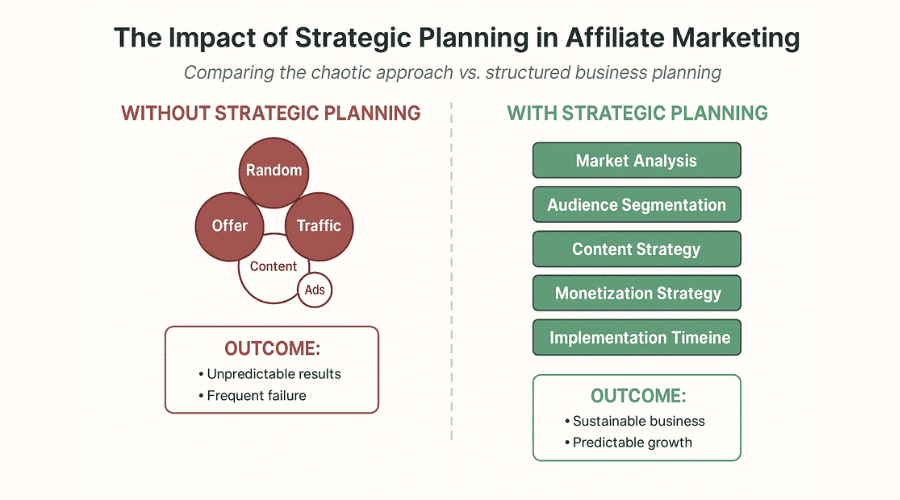
The Strategic Affiliate’s Playbook: Building a Sustainable Business Through Effective Planning
After 20+ years in the affiliate marketing trenches, I’ve seen countless marketers come and go. Want to know the brutal truth? The vast majority fail not because they lack skills or dedication, but because they’re playing checkers in a chess world.
Let me be direct: if you’re launching campaigns without a comprehensive business plan, you’re not running a business—you’re gambling.
- The Strategic Affiliate’s Playbook: Building a Sustainable Business Through Effective Planning
- The Affiliate Business Plan: My Practical Framework
- 1. Market Analysis That Actually Drives Decisions
- Step 1: Vertical Selection & Validation
- Step 2: Audience Identification & Segmentation
- Step 3: Competitive Gap Analysis
- 2. Creating a Distinctive Value Proposition
- 3. Content Strategy That Drives Conversions
- 4. Real-World Revenue Projections
- 5. Diversification Strategy (Critical for Sustainability)
- Your 90-Day Affiliate Business Launch Plan
- Week 1-2: Foundation Building
- Week 3-4: Infrastructure Development
- Week 5-8: Content Creation Phase 1
- Week 9-12: Optimisation and Scaling
- The Mindset of Successful Affiliate Marketers
- Final Thoughts: The Path Forward
Why Most Affiliate Marketers Fail (And How You Can Succeed)
I’ve mentored hundreds of affiliate marketers over the years, and I keep seeing the same pattern. They discover a “hot offer,” throw up a landing page, run some traffic, and pray for commissions. Or they build a large content site on an expired domain, spend hours on it and hope it works. When it doesn’t work (and it usually doesn’t), they jump to the next shiny object.
The affiliate marketing industry continues growing exponentially—U.S. spending reached approximately $8.2 billion in 2022 according to the Performance Marketing Association, and the trend continues upward. But here’s what the gurus won’t tell you: as the industry expands, it’s becoming increasingly competitive and sophisticated. The days of easy wins are over.
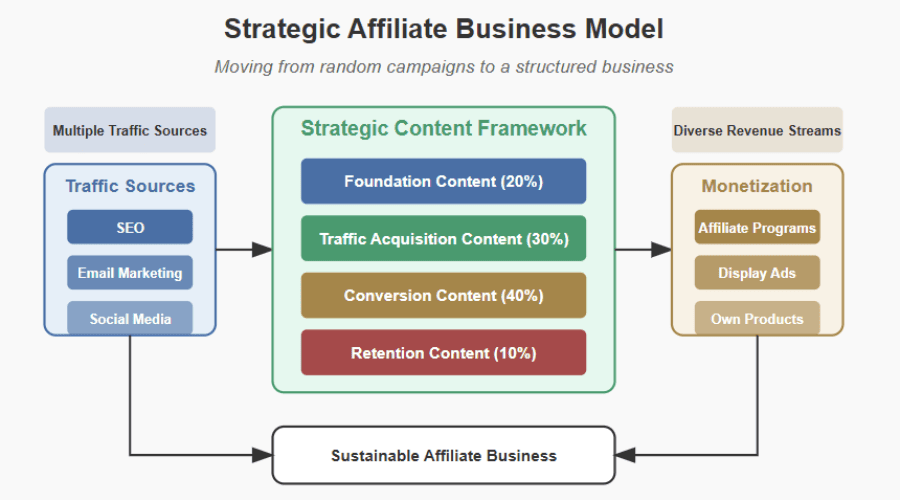
Don’t believe anyone promising overnight riches. I’ve been doing this for two decades, and I’ve never seen sustainable success without strategic planning. Never.
The Affiliate Business Plan: My Practical Framework
Let me share the exact planning framework I’ve refined over 20 years. This isn’t theoretical—it’s the actual process I use for every new affiliate business I have helped launch.
1. Market Analysis That Actually Drives Decisions
Most affiliates do superficial research that leads nowhere. Here’s my three-step process that actually produces actionable insights:
Step 1: Vertical Selection & Validation
I always analyse potential verticals based on three critical factors:
- Commission value and structure (high-ticket vs. recurring)
- Competition saturation (using tools like Ahrefs and SEMrush)
- My personal interest and expertise (crucial for long-term motivation)
From my experience, the most sustainable affiliate verticals share specific characteristics:
- Multiple competing merchants (never build around a single program)
- Established affiliate programs with reliable payment histories
- Clear buyer’s journey with identifiable pain points
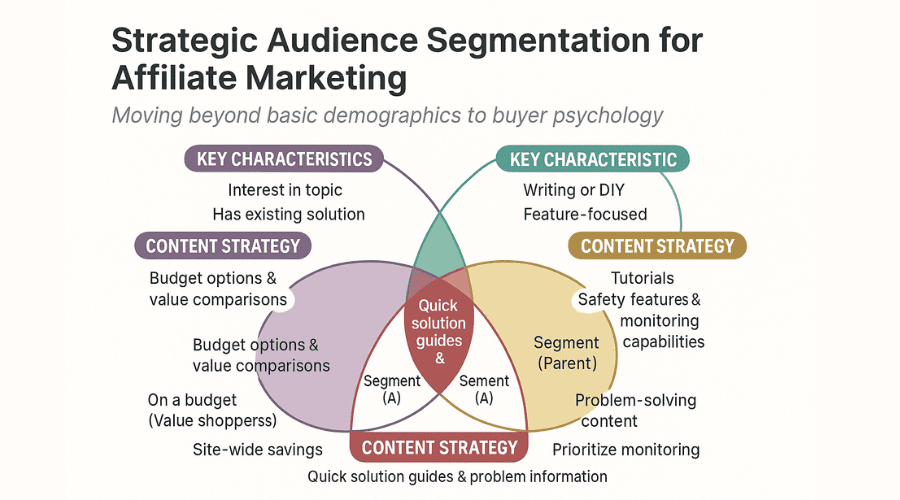
Here’s where most affiliates go wrong—they think in terms of demographics rather than buyer psychology. I focus on understanding:
- What triggers the initial search for information?
- What objections prevent purchase decisions?
- Where does confusion exist in the buying process?
- What unique angle can I provide that others miss?
For each project, I develop audience personas based on real behaviour patterns I’ve observed. For example, in the home security niche, I identified these distinct segments:
- First-time homeowners (motivated by protection, overwhelmed by options)
- Tech enthusiasts (focused on features, willing to DIY)
- Parents of young children (prioritise monitoring capabilities)
- Recent crime victims (urgent need, emotion-driven decisions)
Each segment requires different content, different product recommendations, and different conversion strategies.
Step 3: Competitive Gap Analysis
I never enter a market without thoroughly understanding what’s already working. My process involves:
- Identifying the top 10 affiliates in my target vertical
- Analysing their content structure, monetisation methods, and unique angles
- Finding content gaps or audience segments they’re underserving
- Determining if I can create something substantially better or different
I’m looking for gaps I can exploit—not to compete directly with established players. Sometimes this means focusing on an underserved sub-niche or audience segment. Other times it means approaching common topics with superior depth or a unique perspective.
2. Creating a Distinctive Value Proposition
This is something almost no affiliate marketing course teaches, but it’s absolutely critical. You need to answer: Why should someone read YOUR content instead of the thousands of other options?
Your value proposition might be based on:
- Specific expertise or credentials you possess
- A unique research methodology or testing process
- Superior depth or comprehensiveness
- A distinctive perspective or philosophy
For example, when I entered the VPN affiliate space (incredibly competitive), my unique angle was focusing exclusively on privacy-focused users rather than streaming capabilities—a deliberate choice to differentiate from the dominant players.
3. Content Strategy That Drives Conversions
Content isn’t just about SEO or traffic—it’s about strategically guiding visitors toward purchase decisions. My content framework has evolved over years of testing:
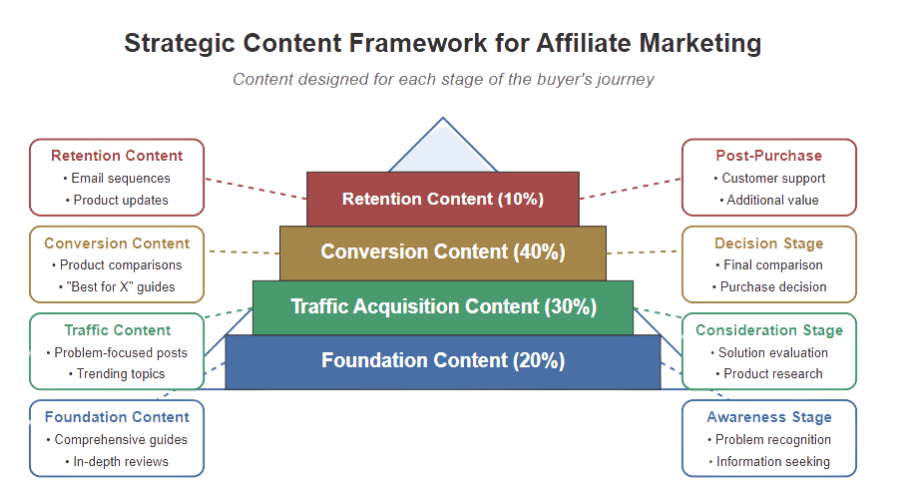
Foundation Content (20% of effort)
- Comprehensive buying guides
- In-depth reviews of top products
Traffic Acquisition Content (30% of effort)
- Problem-focused content that addresses specific pain points
- Trending topics with commercial intent
- Comparison content for buyers in the evaluation stage
Conversion Content (40% of effort)
- Product comparisons between top contenders
- “Best for X” content targeting specific use cases
- Ultimate guides with clear recommendations
Retention and Monetisation Content (10% of effort)
- Email sequences for various buyer journeys
- Product update information
- Advanced usage guides for post-purchase value
For each content type, I have specific templates that I’ve tested and refined over the years. The key is ensuring each piece serves a strategic purpose in the buyer’s journey—not just chasing traffic.
4. Real-World Revenue Projections
One of the biggest mistakes I see is affiliates creating wildly unrealistic revenue projections. Let me give you some hard truth from my two decades of experience:
Typical Timeline for a New Affiliate Site:
- Months 1-3: Infrastructure building, content creation, zero revenue
- Months 4-6: Initial traffic, minimal revenue ($0-500/month)
- Months 7-12: Growing traffic, revenue begins scaling ($500-2,000/month)
- Year 2: If executed well, potential for significant growth ($2,000-10,000/month)

These figures assume consistent execution and proper planning. Could you hit these numbers faster? Possibly, with paid traffic or in less competitive niches. Could it take longer? Absolutely, especially in competitive verticals or with limited time investment.
The point is to set realistic expectations and plan accordingly. This is a business, not a lottery ticket.
5. Diversification Strategy (Critical for Sustainability)
This is perhaps the most important lesson I’ve learned in 20 years: never depend on a single traffic source, merchant, or monetisation method.
My standard diversification framework includes:
- At least 3-5 merchant relationships in any given vertical
- Diverse monetisation methods (affiliate commissions, display ads, and eventually proprietary products)
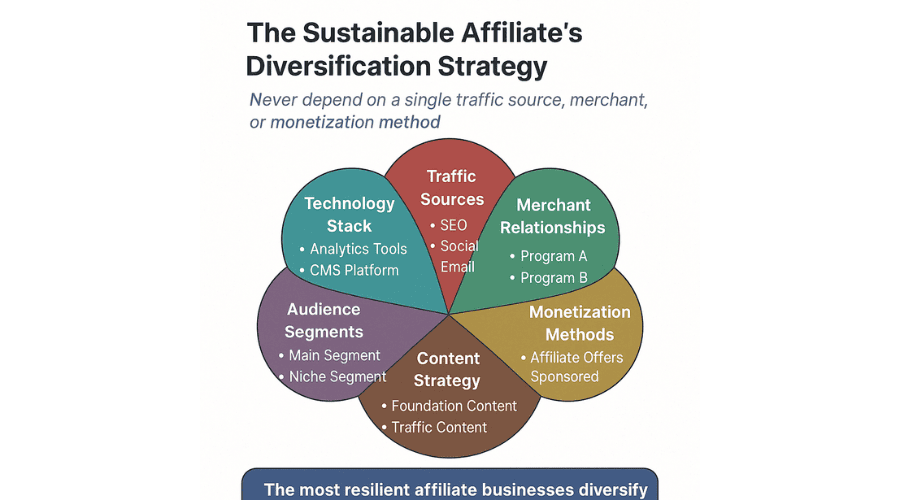
I’ve seen too many affiliates build successful businesses only to lose everything overnight due to program changes, algorithm updates, ad platform policy changes, or merchant issues. Diversification isn’t just smart—it’s survival.
Your 90-Day Affiliate Business Launch Plan
Let me give you a concrete, actionable plan based on my experience. This isn’t theory—it’s exactly what I would do (and have done) when launching a new affiliate business from scratch:
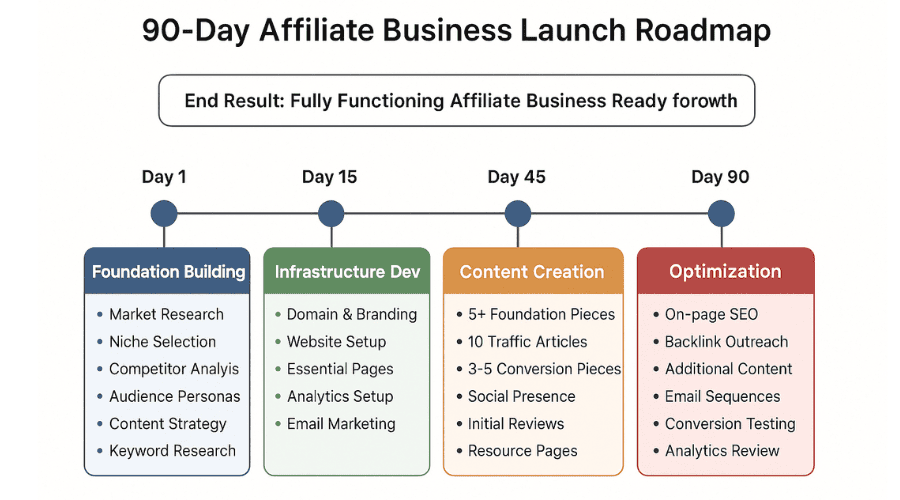
Week 1-2: Foundation Building
- Day 1-3: Market research and niche selection
- Day 4-7: Competitor analysis
- Day 8-10: Audience segmentation and persona development
- Day 11-14: Content strategy development and initial keyword research
Week 3-4: Infrastructure Development
- Day 15-17: Domain selection and brand development
- Day 18-21: Website setup and essential pages (about, contact, privacy policy, affiliate disclosures)
- Day 22-24: Analytics and tracking implementation
- Day 25-28: Email capture setup and initial automation
Week 5-8: Content Creation Phase 1
- Create 5 comprehensive foundational content pieces
- Develop 10 targeted traffic acquisition pieces
- Create 3-5 high-conversion comparison or “best for” pieces
Week 9-12: Optimisation and Scaling
- Implement initial on-page SEO optimisations
- Begin outreach for backlinks and visibility
- Create 5-10 additional content pieces based on opportunity gaps
- Develop and implement initial email nurture sequences
By the end of this 90-day plan, you’ll have:
- A fully functioning affiliate website
- 20+ strategic content pieces targeting different stages of the buyer’s journey
- Initial traffic acquisition channels established
- Conversion infrastructure in place
- Foundation for sustainable growth
This isn’t a get-rich-quick plan. It’s a structured approach to building a real business that can generate income for years to come.
The Mindset of Successful Affiliate Marketers
After two decades in this industry, I’ve noticed that successful affiliates think differently than the rest. They:
- Take a long-term perspective – They’re building assets, not chasing quick commissions
- Focus on audience needs first – They solve problems, not just promote products
- Embrace testing and optimisation – They let data guide decisions
- Invest in their knowledge – They constantly learn and adapt
This mindset shift is perhaps the most important factor in sustainable success. Affiliate marketing isn’t about quick hacks or gaming the system—it’s about creating genuine value and strategically monetising that value.
Final Thoughts: The Path Forward
The affiliate marketing landscape has changed dramatically in the 20+ years I’ve been in this industry. What hasn’t changed is the fundamental principle that separates successful affiliates from the rest: treating it like a real business.
A comprehensive business plan transforms affiliate marketing from a speculative side hustle into a structured business with predictable outcomes. While the industry will always involve some uncertainty, a well-constructed plan provides both a roadmap and a framework for navigating the inevitable challenges.
The question isn’t whether you can afford to invest time in creating a comprehensive affiliate marketing business plan—it’s whether you can afford not to.
If you’ve found this guide valuable, I’d love to hear from you. What part of your affiliate business planning process do you struggle with most? Reach out directly – I am available on most social platforms. After two decades in the trenches, there’s nothing I enjoy more than helping others build sustainable affiliate businesses.


